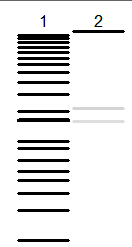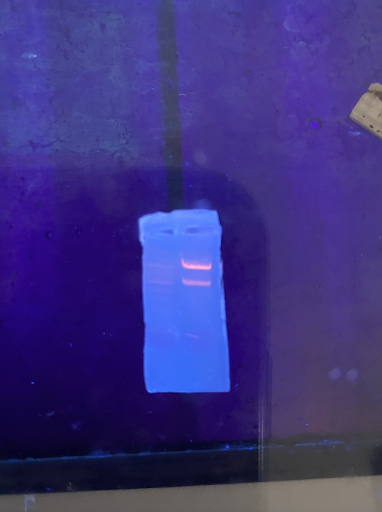Julia Ahearn ’24 and Noah Springhorn ’24: Antagen Pharmaceuticals
- The Rivers School

- Sep 8, 2023
- 4 min read

Vaccination is crucial to modern medicine and saves millions of lives yearly. With the Covid-19 pandemic, we all saw just how necessary vaccination is to society. Vaccines are constantly evolving and improving to help combat many challenges, including accessibility, efficiency, and strength. This is why we were so excited to get the chance to work under Dr. Wenda Gao at Antagen Pharmaceuticals this summer and to learn about molecular biology and biochemistry in a lab setting. Dr. Gao has a Ph.D. in immunology from Tufts and completed a postdoc at Harvard. His accomplishments include being published twice in Nature, the world's leading multidisciplinary scientific journal, and collaborating with major universities, including Harvard and Boston University. Our work in the lab focused on upstream research to combat and treat many diseases, such as malaria, HIV, and cancer.
Julia counting cells (Left), Image of cells through microscope (Right)
The whole research project begins with a hypothesis. Questions and curiosity are what drive the innovation of new technologies. Dr. Gao stressed the importance of asking good questions and working hard to find an answer. During our initial week at Antagen, Dr. Gao guided us through the protocols that we would use to help the process of answering his hypothesis. After observing the protocols, we could perform them independently by the second week. We learned the proper techniques for pipetting and measuring samples and the importance of concise labeling and organization. When working in a lab, we learned you must pay close attention to detail to obtain viable and accurate results.
Some protocols we learned include the following:
Mini-prep: Extracting plasmid DNA from LB cultures for genetic analysis
DNA Digestion: Cutting DNA using enzymes for analysis and manipulation
Ligation & Transformation: Joining DNA fragments and introducing them into cells via enzymes
PCR (Polymer chain reaction): Amplifying DNA segments for analysis and cloning
Agarose Gel Electrophoresis: Separating DNA fragments for visualization
“Electronic cloning”: Analyzing DNA sequences with the APE software to assist cloning
Electroporation: Opening cell membranes using an electric field for DNA introduction
Immunomagnetic cell separation: Magnetic beads separating antigen-expressing cells and non-antigen-expressing cells
ELISA: (Enzyme-Linked Immunosorbent Assay) Detecting proteins by using antibodies

Theoretical results of DNA digestion in gel experiment Actual results
During our time at Antagen, we worked on a multitude of different projects. One particularly significant project could result in new therapeutics for acute myeloid leukemia (AML). This project extended before and after our internship. In this experiment, we observed two groups of mice, each injected with 1 million murine AML line (TIB-49) cells. However, using CRISPR gene editing technology, the TIB cells injected into the experimental group had a specific gene removed. We then monitored the lifespan of the mice with the modified TIB cell injection and found that the mice lived significantly longer. While the control group injected with wild type TIB cells succumbed to leukemia around day 40, the experimental group had a 100% survival rate over 90 days post cell infusion. These results helped back Dr. Gao’s hypothesis that this specific gene was necessary for the metastasis of this particular cancer, which in turn means that future researchers can develop therapeutics targeting this gene product for AML treatment.

A major aspect of Antagen’s research is animal work. We were lucky enough to observe and participate in many different experiments and dissections of mice. During the second week of our internship, we assisted Dr. Gao in an experiment to measure the half-life of an injected antibody in mice. Following an initial injection of 14 mice on Monday, we helped draw blood from the tails of the mice after 1 hr, 24 hrs, 48 hrs, 72 hrs, 96 hrs, and 1 week. To draw blood, we placed mice one at a time under lamps to bring more blood into their tails. After a few minutes under the heat, we would put the mice in a confined chamber and then take blood which would be tested later. Additionally, under the supervision of Dr. Mao, a colleague of Dr. Gao, we were able to dissect mice that had been injected with TIB cancer cells. From here, we removed the spleen and the bone marrow from the femur. The cells collected from the bone marrow and spleen are optimal for observation because they are dendritic cells (DC), stimulating T cell responses and providing tumor protection in vivo. These cells stay viable, allowing doctors to study the TIB cancer cells.

This internship was an incredible opportunity to learn more about molecular biology and biochemistry while developing laboratory skills and learning more about the research process. Dr. Gao taught us the importance of understanding the big picture and questioning why an experiment went wrong; we learned how to push through adversity when results weren't what we had hoped for and how to adapt to unexpected challenges. We would like to thank Dr. Gao and Antagen Pharmaceuticals for opening their lab to us and providing an incredible learning experience this summer. We would also like to thank Mr. Schlenker for giving us this wonderful opportunity.











Comments